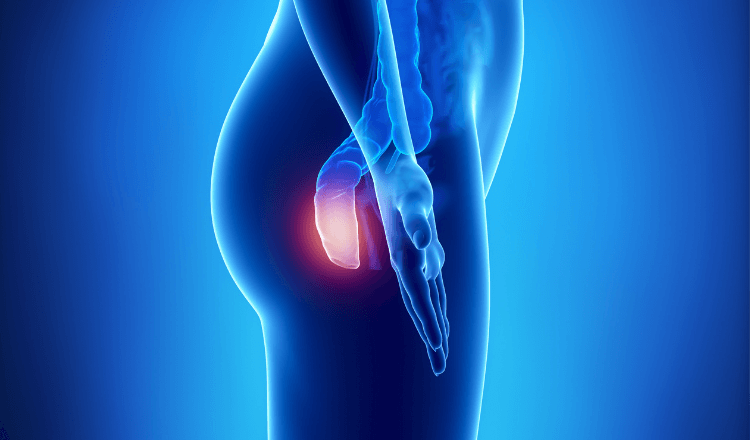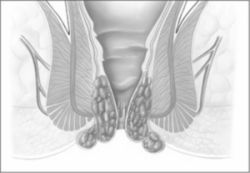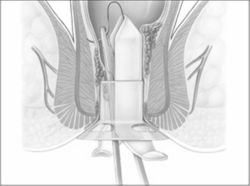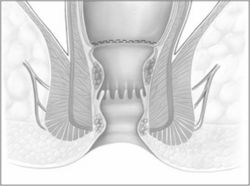
Hemorrhoids
Hemorrhoids, also called piles, are swelling and inflammation of veins in the rectum and anus.
In fact, having a “cushion” of blood vessels and tissue is normal in the rectum and anus, and the proper term for this cushion is in fact the word “Hemorrhoid”. This normal cushion is what helps keep control over stool and prevent flatulence. However, when the cushion becomes painfully enlarged and inflamed, this condition has been called having hemorrhoids.
Symptoms
The most common symptom is of hemorrhoids is bloody discharge and bloody stool. This is usually accompanied by pain, perianal mucous discharge, itching and pressure or a burning sensation in the rectal region. In later stages, there may be an external lump or mass of rectal tissue (prolapsed hemorrhoids). Heavy bleeding, rectal spasms leading to pinched hemorrhoids (prolapsed and strangulated hemorrhoids) and incontinence. These symptoms require medical treatment.
Diagnosis
A proctoscope (a small narrow ridged tube with a light source) is used to diagnose hemorrhoids. The proctoscope is inserted into the rectum and then slowly removed. The hemorrhoids if any, are exposed, as well as how many and what stage they are, whether inflamed or if fistulas have developed and other factors. The entire examination lasts about 2-3 minutes and is entirely painless.
Therapy
Conservation therapy
Patient with hemorrhoids must take care to maintain a soft and regular stool. Constipation and diarrhea aggravate hemorrhoids. This can be avoided by increasing the amount of fiber in the diet, increasing the intake of fluids and by regular exercise. In cases of extreme constipation, it may be necessary to use laxatives, however this should only be a temporary measure, as laxatives can become habit forming. Topical treatment using medicated creams or a tamponade may help reduce discomfort of the symptoms, but will not treat the cause of the hemorrhoids.
Grade I and II hemorrhoids
There are two treatments for this degree of hemorrhoids. The first is sclerotherapy. The hemorrhoids are injected with sclerosant, a hardening agent that cause the walls of the blood veins to collapse and the hemorrhoids to whither. The second is rubber band ligation. An elastic band is wound tightly around the hemorrhoid. This strangles the blood supply causing the hemorrhoid to whither. The hemorrhoid is expelled with normal stool after about 2-3 weeks. These procedures are not painful and can be repeated when needed.
Grade III Hemorrhoids

Prolapsed hemorrhoids (hemorrhoids that protrude outside the anus) can be pushed back inside with the hand or with instruments. The severity of this grade of hemorrhoids usually requires surgical treatment for complete and lasting cure. One of two procedures is used, depending on the type of hemorrhoids. Both procedures can be undertaken in full anesthesia or local anesthesia.
Gerne beraten ich Sie persönlich in unserer Praxis in München. Sie können und telefonisch unter 089-51660920 oder per Email unter info@chirurgie-herter.de erreichen oder online auf doctolib einen Termin vereinbaren.
Operation
Treatment under regional anesthesia or general anesthesia
Usually able to work again after 1 week
Discharge on the same day or the day after
Conventional Open Hemorrhoidectomy
The conventional surgical procedure is well known and has been used for decades. The patient is placed in full or local anesthesia and the inflamed hemorrhoids are surgically removed. The patent can usually leave the hospital the same or next day.
Minimal Invasive Surgical Procedure (Stapled Hemorrhoidectomy from Longo)
Minimal Invasive Surgical Procedure (Stapled Hemorrhoidectomy from Longo)
This surgical procedure has been developed and practiced in the last ten years and is routinely used in this practice. A 2-3 cm wide strip of the rectal mucous membrane is removed with a special surgical instrument. A part of the hemorrhoid is also removed, and the rest is pulled up into the anal canal. The cause of the hemorrhoids, the inflamed mucous membrane, is removed thus curing the swollen hemorrhoids.
The advantages of this type of procedure are that the operation, when conducted by an experienced surgeon is fast, safe and reliable, and nearly painless compared to conventional methods. Properly executed, this procedure has little risk of remaining incontinence, and the probability of reoccurrence is reduced. The patent can leave the hospital the same or next day.


Testimonial from a patient:
Very nice place, I had nice experience there with operation and the doctor is very careful and taking good care after my surgery.
Source: Google

Prognosis
Swelling, pain and pressure discomfort usually last only a short time after surgery, and can be treated with mild painkillers. Hemorrhoid symptoms usually disappear immediately after the minimal invasive surgery. In rare cases there may be a short-term stress induced incontinence that generally clears up by itself. The staples gently disengage themselves from the rectum and are expelled during normal bowel movement. Patients are usually released from the hospital on the same or the next day, and can return to work after a week.
Notice: Preoperative preparation: Please inform your physician if you are taking blood thinning medication such as Aspirin® and Marcumar® as they may lead to complications during surgery.
Your health is
important to us
Office Hours
Monday, Tuesday, Wednesday: 8:30 – 16:00
Thursday: 8:30 – 18:00
Friday: 8:30 – 13:00
and by appointment
